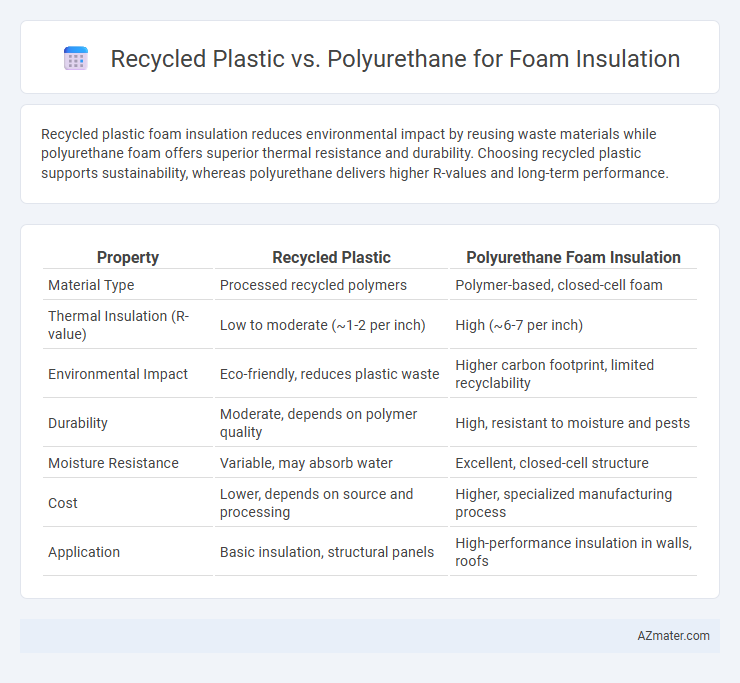Recycled plastic foam insulation reduces environmental impact by reusing waste materials while polyurethane foam offers superior thermal resistance and durability. Choosing recycled plastic supports sustainability, whereas polyurethane delivers higher R-values and long-term performance.
Table of Comparison
| Property | Recycled Plastic | Polyurethane Foam Insulation |
|---|---|---|
| Material Type | Processed recycled polymers | Polymer-based, closed-cell foam |
| Thermal Insulation (R-value) | Low to moderate (~1-2 per inch) | High (~6-7 per inch) |
| Environmental Impact | Eco-friendly, reduces plastic waste | Higher carbon footprint, limited recyclability |
| Durability | Moderate, depends on polymer quality | High, resistant to moisture and pests |
| Moisture Resistance | Variable, may absorb water | Excellent, closed-cell structure |
| Cost | Lower, depends on source and processing | Higher, specialized manufacturing process |
| Application | Basic insulation, structural panels | High-performance insulation in walls, roofs |
Introduction: The Foam Insulation Dilemma
Recycled plastic foam insulation offers a sustainable alternative by reducing landfill waste and lowering carbon footprint compared to traditional polyurethane foam. Polyurethane foam insulation provides superior thermal resistance with R-values typically ranging from 6 to 7 per inch, ensuring effective energy efficiency for buildings. Choosing between recycled plastic and polyurethane depends on factors like environmental impact, cost, durability, and insulation performance requirements.
What Is Recycled Plastic Foam Insulation?
Recycled plastic foam insulation is made from repurposed plastic waste transformed into lightweight, durable foam that provides excellent thermal resistance and soundproofing. This eco-friendly material reduces landfill waste and lowers the carbon footprint compared to traditional polyurethane foam, which is petroleum-based and less sustainable. Its closed-cell structure ensures high moisture resistance and long-term energy efficiency in building insulation applications.
Understanding Polyurethane Foam Insulation
Polyurethane foam insulation offers superior thermal resistance with R-values typically ranging from 6 to 7 per inch, outperforming most recycled plastic foam alternatives. Its closed-cell structure provides enhanced moisture resistance and structural strength, making it ideal for both residential and commercial applications. While recycled plastic foam prioritizes sustainability, polyurethane insulation excels in durability, energy efficiency, and long-term performance.
Environmental Impact: Recycled Plastic vs Polyurethane
Recycled plastic foam insulation significantly reduces landfill waste and lowers carbon emissions through the reuse of existing materials, promoting a circular economy. Polyurethane foam, derived from petrochemicals, involves energy-intensive production processes and emits greenhouse gases such as isocyanates and blowing agents that contribute to global warming. Choosing recycled plastic insulation supports sustainable building practices by minimizing environmental pollution and decreasing reliance on fossil fuel resources.
Insulation Performance and R-Value Comparison
Recycled plastic foam insulation typically offers a moderate R-value ranging from 3.5 to 4.5 per inch, providing environmental benefits through material reuse but often exhibiting slightly lower thermal resistance compared to polyurethane foam. Polyurethane foam insulation generally delivers a superior R-value between 6 and 7 per inch, resulting in enhanced thermal performance and greater energy efficiency in building applications. The higher density and closed-cell structure of polyurethane contribute to its superior insulation performance, whereas recycled plastic foam's sustainability advantage may influence material selection in green construction projects.
Cost Analysis: Upfront and Long-Term Expenses
Recycled plastic foam insulation generally offers lower upfront costs compared to polyurethane foam due to the use of reclaimed materials and simplified manufacturing processes. Over the long term, polyurethane foam provides superior thermal performance and durability, potentially reducing energy expenses and maintenance costs despite its higher initial price. Evaluating total cost of ownership requires balancing immediate savings of recycled plastic foam against the efficiency and lifespan benefits of polyurethane insulation.
Durability and Longevity in Building Applications
Recycled plastic foam insulation offers notable durability through resistance to moisture, mold, and chemical degradation, maintaining performance over extended periods in building applications. Polyurethane foam insulation excels in longevity with high structural integrity, superior thermal resistance, and resistance to compression, making it ideal for long-term energy efficiency. Both materials provide durable insulation solutions, but polyurethane typically outperforms recycled plastic foam in longevity under extreme conditions and sustained load pressures.
Health and Safety Concerns
Recycled plastic foam insulation often contains fewer volatile organic compounds (VOCs) compared to polyurethane foam, reducing indoor air quality risks. Polyurethane foam may emit isocyanates during installation, which can cause respiratory irritation and sensitization without proper protective equipment. Both materials require adherence to safety standards, but recycled plastic foams generally present lower acute toxicity concerns during and after installation.
Installation Process and Ease of Use
Recycled plastic foam insulation typically requires standard cutting and fitting tools, making installation straightforward and compatible with common construction practices, while also offering the benefit of being lightweight and easy to handle. Polyurethane foam insulation often demands specialized spray equipment and professional application due to its expanding properties and chemical components, which can complicate the installation process and increase labor costs. The ease of use of recycled plastic foam is generally higher for DIY projects, whereas polyurethane foam, despite its superior insulation value, is better suited for experienced installers because of safety and precision requirements.
Future Trends in Sustainable Foam Insulation
Recycled plastic foam insulation is gaining momentum due to its lower environmental impact, reduced carbon footprint, and enhanced recyclability compared to traditional polyurethane foam. Innovations in bio-based polyurethane formulations and hybrid materials are driving improved thermal performance and biodegradability in sustainable foam insulation. Market trends indicate increasing adoption of circular economy principles, emphasizing material reuse and energy efficiency to meet stringent green building standards globally.

Infographic: Recycled plastic vs Polyurethane for Foam insulation
 azmater.com
azmater.com